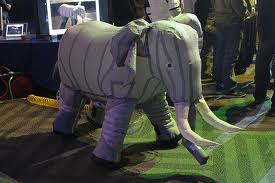
Pneubot stands for "pneumatic robot", or a robot that is actuated by pneumatic technology. A pneumatic technology involves the use of compressed air to drive mechanical motion. The compressed air can be moved through soft, balloon-like tubes, which allows for both rigidity (when filled) and flexibility (when decompressed or empty). In this video, an elephant-shaped pneubot is used to demonstrate the level of motor control allowed using this technology.
MAKE #27
Pneubotics: Walking Bouncy Castles
By Saul Griffith
Sometimes I feel like a false nerd, or a geek with two important genes missing: I’m not particularly interested in space exploration, except as fiction, and I’ve never cared for robots. So I find it strange that I’m now working on a Defense Advanced Research Project Agency (DARPA) robotics program.
I think what I never liked about robots is that they’re complex machines that really don’t do much. They’re fragile and very expensive. I like simple, robust things; things that don’t cost more than they should.
What I’ve found myself working on (with Jack Bachrach, Geoffrey Irving, Pete Lynn, and the good guys from Meka Robotics) is completely soft, completely compliant, very lightweight, and very cheap. No joints. No servos. Just skins — inflated skins.
For a long while I’ve been fascinated by inflatable objects for their extreme strength-to-weight ratios (they can carry a lot of load for very little mass). I also love the challenge of designing something “human safe,” in the robotics lexicon. Biology doesn’t use metal, and it doesn’t use servos. Nature points to some very interesting alternatives.
To make it work, we had to invent a new kind of actuator. Think of it as a vascular system for robots. It’s fluidic — works equally well with air or water — and by pumping either of those around, you can change the dimensions of the skin and effect motion. Our first actuator was quite literally a bicycle inner tube in a sewn pair of membranes. It worked really well for a $5 prototype!
For the next trial, I asked my sister to return an inflatable 4-foot-high elephant I’d designed and given to my niece. When it arrived, Pete burned the midnight oil and sewed up some vascular “muscles,” and in a day or two we had four moving legs. It actually walked. About one mile every 24 hours, but hey — baby’s first steps! It moves like no machine you’ve ever seen; more like the way biology moves. A walking inflatable elephant might sound ridiculous, but it works, and the numbers on paper told us it should have incredible strength, good speed, extremely low weight, and cost very, very little to manufacture.
The next prototype was designed to walk with a human rider on it and to look less like an elephant. We built it in under a week for less than $1,000 in parts. A 15-foot-long, 5-foothigh robot with 28 muscle actuators (four in each of six legs, another four in the trunk). It worked too (after a few exploded actuators).
I like the idea of a robot you can sew together. I like that it has no heavy, sharp, or costly parts. Most of all, I like the intellectual challenges of it. There aren’t any CAD packages for designing highly elastic kinetic membrane structures. We had to write our own. There aren’t any analysis simulations. We had to write our own. There aren’t any walking bouncy castles out there. We built our own! We call our weird new style of robotics “pneubotics,” as in pneu for air (like pneumatic).
Who knows if the robotics community will like it or even care. Either way, that’s not why I built it. I built it because perhaps my niece will forgive me if she gets a walking elephant next Christmas that she can ride to school.
All pictures and captions sourced from Otherlabs webpage unless noted otherwise. See Otherlabs webpage and other videos here.
OtherLab is a collective of scientists and inventors involved in a number of projects, including proof-of-concept mechatronics that might be useful in building functionally adaptive and intelligent machines.
See other Pneumatic, Fluidic, and Inflatable robots here.